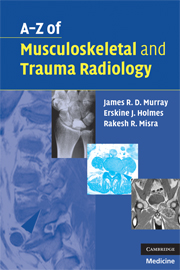Book contents
- Frontmatter
- Contents
- Acknowledgements
- Preface
- List of abbreviations
- Section I Musculoskeletal radiology
- Section II Trauma radiology
- ATLS – Advanced Trauma Life Support
- Acetabular fractures
- Aortic rupture
- Cervical spine injury
- Flail chest
- Haemothorax
- Open fractures
- Pelvic fracture
- Peri-physeal injury
- Pneumothorax
- Rib/sternal fracture
- Skull fracture
- Thoraco-lumbar spine fractures
- Acromioclavicular joint injury
- Carpal dislocation and instability
- Clavicular fractures
- Elbow injuries and distal humeral fractures
- Hand injuries – general principles
- Hand injuries – specific examples
- Thumb metacarpal fractures
- Humerus fracture – proximal fractures
- Humerus fracture – shaft fractures
- Humerus fracture – supracondylar fractures – paediatric
- Radius fracture – head of radius fractures
- Radius fracture – shaft fractures
- Galeazzi fracture dislocation
- Radius fracture – distal radial fractures
- Related wrist fractures
- Scaphoid fracture
- Scapular fracture
- Shoulder dislocation
- Ulna fracture – proximal and olecranon fractures
- Ulna fracture – shaft fractures
- Monteggia fracture dislocation
- Accessory ossicles of the foot
- Ankle fractures
- Bone bruising
- Calcaneal (Os calcis) fractures
- Femoral neck fracture
- Femoral shaft fracture
- Femoral supracondylar fracture
- Hip dislocation – traumatic
- Knee soft-tissue injury
- Metatarsal fractures – commonly fifth MT base
- Patella fracture
- Tibial-plateau fracture
- Tibial-shaft fractures
- Tibial-plafond (Pilon) fractures
- Talus fractures/dislocations
Ulna fracture – proximal and olecranon fractures
from Section II - Trauma radiology
Published online by Cambridge University Press: 22 August 2009
- Frontmatter
- Contents
- Acknowledgements
- Preface
- List of abbreviations
- Section I Musculoskeletal radiology
- Section II Trauma radiology
- ATLS – Advanced Trauma Life Support
- Acetabular fractures
- Aortic rupture
- Cervical spine injury
- Flail chest
- Haemothorax
- Open fractures
- Pelvic fracture
- Peri-physeal injury
- Pneumothorax
- Rib/sternal fracture
- Skull fracture
- Thoraco-lumbar spine fractures
- Acromioclavicular joint injury
- Carpal dislocation and instability
- Clavicular fractures
- Elbow injuries and distal humeral fractures
- Hand injuries – general principles
- Hand injuries – specific examples
- Thumb metacarpal fractures
- Humerus fracture – proximal fractures
- Humerus fracture – shaft fractures
- Humerus fracture – supracondylar fractures – paediatric
- Radius fracture – head of radius fractures
- Radius fracture – shaft fractures
- Galeazzi fracture dislocation
- Radius fracture – distal radial fractures
- Related wrist fractures
- Scaphoid fracture
- Scapular fracture
- Shoulder dislocation
- Ulna fracture – proximal and olecranon fractures
- Ulna fracture – shaft fractures
- Monteggia fracture dislocation
- Accessory ossicles of the foot
- Ankle fractures
- Bone bruising
- Calcaneal (Os calcis) fractures
- Femoral neck fracture
- Femoral shaft fracture
- Femoral supracondylar fracture
- Hip dislocation – traumatic
- Knee soft-tissue injury
- Metatarsal fractures – commonly fifth MT base
- Patella fracture
- Tibial-plateau fracture
- Tibial-shaft fractures
- Tibial-plafond (Pilon) fractures
- Talus fractures/dislocations
Summary
Characteristics
Usually secondary to a fall on an outstretched hand or a direct blow.
Less commonly caused by triceps contraction with a flexed elbow.
Extra-articular avulsion fractures less common than intra-articular ‘true’ olecranon fractures.
Undisplaced fractures are defined (Colton) as having < 2 mm displacement, active flexion to 90° and active extension.
Clinical features
Localised pain, bruising crepitus over the olecranon.
A palpable separation may be felt.
Inability to extend the elbow against gravity indicates complete disruption of the extensor mechanism.
Assess ulna and anterior interosseous nerve function as injury can occur at the time of trauma and in treatment with ORIF.
Radiological features
AP and true lateral flexed elbow. Displacement best evaluated on the lateral.
Again be aware of epiphyseal appearances. A bifid epiphysis is normal although fusion should occur by 14 years. Rounded calcification within the triceps tendon can also be misleading.
Important to assess the size of the proximal fragment – may require excision – and the degree of fragmentation – which may determine treatment modality.
Management
Assess soft tissues, neurovascular status and immobilisation initially with above elbow backslab.
Undisplaced – immobilise in approximately 90° of flexion. Reassess that no displacement at 1 week and mobilise around 4 weeks.
Non-operative treatment can also be applied to displaced fractures in the elderly, low-demand, high surgical-risk patient – here the aim of treatment is pain-free fibrous union or even pseudarthrosis and therefore mobilisation should be as early as possible to prevent joint stiffness.
Displaced – requires ORIF with k-wires and tension band or reconstruction plate for the multi-fragmentary fracture. Early mobilisation if possible.
Avulsion fractures – if the proximal fragment is small, excision and reattachment of the triceps with suture anchors allows early mobilisation, maintains reasonable joint congruence and stability.
- Type
- Chapter
- Information
- A-Z of Musculoskeletal and Trauma Radiology , pp. 282 - 283Publisher: Cambridge University PressPrint publication year: 2008

